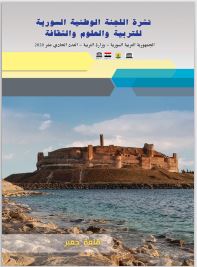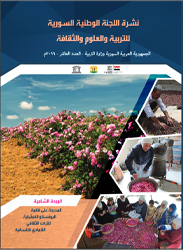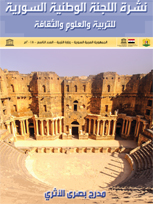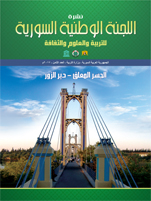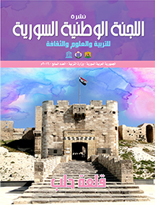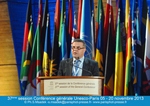Bosra Sham
|
- Bosra, once the capital of the Roman province of Arabia, was an important stopover on the ancient caravan route to Mecca. A magnificent 2nd-century Roman theatre, early Christian ruins and several mosques are found within its great walls.
- The name of Bosra occurs in the precious Tell el-Amarna tablets in Egypt, which date from the 14th century B.C. and represent royal correspondence between the Pharaohs and the Phoenician and Amorite kings. It became the northern capital of the Nabataean kingdom. In the year of 106 A.D, a new era began for Bosra when it was incorporated into the Roman Empire. - Alexander Severus gave it the title Colonian Bostra and Philip the Arab minted currency especially for it. During Byzantine times, Bosra was a major frontier market where Arab caravans came to stock up and its bishops took part in the Council of Antioch. Bosra was the first Byzantine city which the Arabs entered in 634 in the phase of Islamic expansion. - Today, Bosra is a major archaeological site, containing ruins from Roman, Byzantine, and Muslim times. Further, Nabataean and Roman monuments, Christian churches, mosques and Madrasas are present within the city. - Its main feature is the second century Roman Theatre, constructed probably under Trajan, which has been integrally preserved. It was fortified between 481 and 1251 AD. Al-Omari Mosque is one of the oldest surviving mosques in Islamic history, and the Madrasah Mabrak al-Naqua is one of the oldest and most celebrated of Islam. The Cathedral of Bosra is also a building of considerable importance in the annals of early Christian architecture. - Bosra survived about 2500 years inhabited and almost intact. The Nabataeans, Romans, Byzantines and Umayyad, all left traces in the city, which is an open museum associated with significant episodes in the history of ideas and beliefs. - Criterion (i): The incorporation of the exceptionally intact 2nd century Roman theatre, complete with its upper gallery, into later fortifications to create a strong citadel guarding the road to Damascus represents a unique architectural achievement. The remains of the 6th century basilica of the martyrs Sergios, Bacchos and Leontios, the cathedral of Bosra, represent an extremely significant example of the centrally planned churches in terms of the evolution of early church architectural forms. The Mosque of Omar, restored in 1950, is one of the rare constructions of the 1st century of the Hegira preserved in Syria. The Madrasa Jâmi' Mabrak an-Nâqua is one of the oldest and most celebrated of Islam. - Criterion (iii): Of the city which once counted 80,000 inhabitants there remain today extensive ruins of Nabataean, Roman, Byzantine and Umayyad buildings. These ruins, including the major monuments mentioned under Criterion (i) above bear exceptional testimony to the past civilizations that created them. - Criterion (vi): In Islam, Bosra is associated with a significant episode in the life of the Prophet Mohammed, who is believed to have visited Bosra twice. At the end of his first visit, it is said that Monk Baheira indicated that Muhammad was to become a prophet. Integrity (2009) - The Ancient city of Bosra is an inhabited archaeological site whose ruins had suffered greatly in the late 19th century. However, the large amount of surviving original fabric, including monuments of the Nabataean, Roman, Byzantine and Umayyad periods gives the site a high degree of integrity. The inhabitants of the village that has grown up amongst the ruins are being resettled outside the property. There is a need to define and manage a buffer zone to protect the setting. Authenticity (2009) - The key surviving monuments of Bosra reflect the Outstanding Universal Value of the site. However, their setting is problematic in that a modern village had grown up among the ruins. A resettlement policy of the Directorate of Antiquities and Museums (DGAM) is allowing most families to move to new houses outside the precincts of the old town. Ultimately the old town will be abandoned again, to be turned into a dead city revitalized as an open air museum. Protection and management requirements (2009) - The property is protected under the Antiquities Law 222 as amended in 1999. There is no management plan for the site and there are problems with conservation due to community issues, lack of funds and technical resources, and a lack of skilled labour. The Directorate of Antiquities and Museums is attempting to overcome these problems with the help of national and international institutions and foreign experts. - Recently the Syrian Government instigated a Master Plan project to recognize the importance of the site and to guide future use of Bosra city. A Protection Committee was established in 2007 to guide the project. - The DGAM is preparing terms of reference for implementing GIS system in the site; this project will start during 2009 and will continue for 1 year. There is a need to protect the setting of the property through an agreed and approved buffer zone. Long Description - Bosra is associated with important events in the history of ideas and beliefs: according to tradition its bishop took part in the Council of Antioch, while the Prophet Muhammad came there twice and, at the time of his first visit, is said to have learned the precepts of Christianity from a Nestorian monk named Bahira. The monuments built in different times make Bosra a city of extreme rarity, of universal importance and of unique aesthetic value The old city of Bosra was the northern capital of the Nabataean kingdom of the Roman province of Arabia, referred to in the Bible, in AD 106. It was successively an important religious metropolis of the Byzantine Empire and a caravan centre, in the role of a large frontier market on the pilgrim route to Mecca.The square minarets are without doubt the oldest still standing in the whole of Islam. The significance of the city as an important stop on the way to Mecca and the prosperity that this brought lasted until the 17th century. By then the region was becoming unsafe and pilgrims began to take a less dangerous route further west. - Of the city which once counted 80,000 inhabitants, there remains today only a village of striking beauty, settled among the ruins. The 2nd century Roman theatre, probably built under Trajan, is the only monument of this type with its upper gallery in the form of a covered portico that has been integrally preserved. This unique monument, enclosed by the walls and towers of a splendid citadel fortified between 481 and 1231, alone would suffice for the glory of Bosra. From outside it could be an Arab fortress similar to many others. On a semi-circular front, great square towers built from enormous blocks of stone (some of the corner ones are more than 5 m high) project from the blind ramparts. A deep ditch, the first line of defence, is crossed on a six-arched bridge. An iron-bound gate, a series of vaulted rooms, twisting passages, rampart walks, and all kinds of defensive works give an impression of the military quality of the castle, but there is no preparation for the discovery that right at its heart lies a splendid ancient theatre. - The two structures, both equally fine, are closely integrated into one another. The 13th-century enclosing wall completely encircles the cavea of the theatre. When the Arabs entered Bosra they immediately blocked all the doors and openings of the ancient theatre with thick walls, thus transforming it into an easily defensible citadel. But the new threats posed by the Crusaders rendered these early defences inadequate; so in the mid-11th century three towers were built, jutting out from the Roman building; nine other larger ones followed between 1202 and 1251. Later accretions overlaid the interior of the theatre and its ranges of seats, but at the same time preserved them. This interior has now been fully uncovered and restored in its entire majestic entirety by the Department of Antiquities, which began its work here shortly after Syria became independent. - There is room for 15,000 spectators to face a stage 45 m long and 8.5 m deep, and a stage wall whose base is emphasized by a series of Corinthian columns. Many details of its architecture proclaim the perfection of its construction and the concern of its 2nd-century builders for the comfort of the audience. Furthermore, sources reveal that the whole theatre was draped with silk hangings that protected audiences from both summer sun and winter rain. Perfumed water was also evaporated in the theatre - the ultimate touch of style and refinement. - In Bosra, Nabatean and Roman monuments, Christian churches, mosques and madrasas come together, all equally celebrated: they are to be found within the half-ruined enceinte of the city. The basilica of the martyrs Sergios, Bacchos and Leontios, the cathedral of Bosra, was completed in 513 by Archbishop Julianus. The structure of this monument, a central plan with eastern apses flanked by two sacristies, exerted a decisive influence on the evolution of Christian architectural forms, and to a certain extent on Islamic forms as well. The Mosque of Omar, restored in 1950, is one of the rare constructions of the 1st century of the Hegira preserved in Syria. The Jami' Mabrak an-Naqua madrasa is one of the oldest and most celebrated of Islam. |
View Album / Bosra Sham















